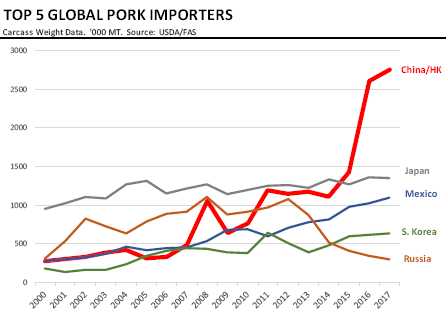



CME: China's Use of Ractopamine Poses Export Challenge
US - Last week the USDA Foreign Agricultural Service released its semi-annual review of global livestock and poultry markets. For all those interested in global trade flows and the outlook for US trade in 2017, we think you will find this 18 page report valuable, reports Steiner Consulting Group, DLR Division, Inc.Below are some of our observations as we look through the USDA analysis:
USDA currently forecasts global pork exports to increase by 5 per cent in 2017. Lower feed costs, not just in the US but other parts of the world, have bolstered pork supplies in key producing countries and that pork will flow into markets where demand is increasing, countries such as China.
But even as Chinese demand is expanding, it does not necessarily mean that the US will be the main beneficiary. As with beef, one of the challenges for expanded access into China remains the use of growth promotants, such as ractopamine.
US producers have in recent years increased the supply of pork from hogs that have not been given ractopamine but it remains an issue for those packers that do not control the product flow and thus are not able to guarantee that hogs at some point were not fed with it.
Combined pork imports for China/Hong Kong in 2017 are forecast to be 2.750 million MT. Mainland China imports alone are expected to be 2.3 million, about the same as what they were last year but more than double what they were two years ago.
European pork producers have been the primary beneficiaries of this resurgence in Chinese pork demand for two reasons: they have meat to sell now that Russia has shut its doors to EU pork and they have meat to sell because feed costs are manageable and EU does not permit the use of ractopamine.
Current USDA forecast is for US pork exports to increase 8.3 per cent from a year ago, which would require continued strong demand from Mexico (our top market) but also continued expansion into major Asian markets, doable considering low US prices and availability.

You can view the USDA Foreign Agricultural Service's semi-annual review of global livestock and poultry markets by clicking here.








